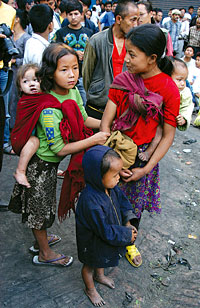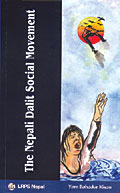|
|
The recent incident of a Dalit woman being barred by her neighbours (see: 'Water for all', #291) from using a village water tap on the outskirts of the capital proves that untouchability remains an entrenched social crime.
That is why the recent translation of a book on the country's Dalit movement is both timely and frustrating. Although the Nepali original is dated 2002 and it was based on the author's masters thesis submitted in 2000, the publishers puzzlingly decided not to update it.
Judging by the landscape of mushrooming Dalit organisations that The Nepali Dalit Social Movement describes in the afterglow of 1990's democratic revolution, it's likely the scene has changed completely in the past six years so it would have been useful to hear the latest. Yet in the Preface, author Yam Bahadur Kisan's argues: 'Adding new content to reflect these changes would have entailed writing an entirely different book.'
That aside, this book, published by the Legal Rights Protection Society Nepal with support from Danida, is a readable introduction both to the origins of the caste system in India and to the inner workings of the anti-discrimination activities here that hardly seem unified enough to deserve the 'movement' label of the title.
To a neophyte, the abundantly researched first chapter on how caste grew from the class system of the new Aryan state taking root in the Indian subcontinent is an eye-opener. But from that point on, the reader is led on a somewhat uneven ride.
|
|
Kisan summarises the history of the growth of Nepal's caste system. In 1854 Jang Bahadur Rana enacted the Muluki Ain which divided Shudras (the labouring class) into 'touchables' and 'untouchables' and further classified them as groups whose touch did or did not require purification. ( an appendix has a shockingly long list of Dalit sub-castes). But the Ranas themselves were quick to overlook and even manipulate these categories and avoid punishments for breaking their own laws when they started keeping concubines from low-caste groups.
Kisan argues that no government before or since 1854 has championed an end to the caste system, not even the democratic ones. And despite prohibitions against untouchability in both the Constitution and the revised Muluki Ain whose provisions are cancelled out by reference to the sanctity of religious acts. 'The ruling class.appears as yet not psychologically ready to accept changes in the caste system,' argues the author.
That is one reason for the proliferation of organisations created to erase the caste system, described in the final five chapters of the book. This is also where the weaknesses of The Nepali Dalit Social Movement begin to show. Primarily, the author relies too heavily on the words of the organisations themselves to describe their positions and activities rather than analysing their deeds.
At times the text reads as if Kisan is listing promises outlined in the groups' constitutions or position papers. What would be more interesting is his own evaluation of the main bodies' activities and a description of trends within the movement over the years. Admittedly, the book took form as a Masters thesis but for readers that is irrelevant-they just want a fulfilling read.
This is not to say that Kisan is not critical of the movement and its leaders, he doesn't hesitate to point out flaws and offer his own recipe for success. For the movement to succeed, Kisan concludes, it will require more acts like 1954's forcing open the doors of Pashupatinath to Dalits. Success will require 'empowerment, unification and struggle.(but) the most important means for Nepali Dalits to achieve their freedom is through struggle, struggle and more struggle'.
"I just want to live as a Nepali"
Bharat Bishwakarma is not ashamed of his roots, but he wants to be free to define them
 As an activist in the 1990 democratic spring, Bharat Biswokarma remembers how the euphoria of freedom slowly ebbed as his friends colleagues joined the political mainstream. But because of his Dalit background Bharat found it much harder. "I saw from the beginning that I was sort of sidelined, I didn't have easy access to the parties. I would have joined but..." he recalls.
As an activist in the 1990 democratic spring, Bharat Biswokarma remembers how the euphoria of freedom slowly ebbed as his friends colleagues joined the political mainstream. But because of his Dalit background Bharat found it much harder. "I saw from the beginning that I was sort of sidelined, I didn't have easy access to the parties. I would have joined but..." he recalls.
Nepal's civil society was ballooning in the 1990s and Dalit rights groups were on the rise. Bharat was offered positions in some of them but declined.
"I didn't want to be labelled as part of a limited group," he says, "I should have the right to live as a Nepali without any other category being imposed on me. If someone wants to be known as an activist or a Dalit or a Janjati that's their right, but I choose not to."
Bharat introduces himself by his surname and says he's not a Dalit. "They say, how come, and I reply I don't know why I should be labelled a Dalit, is it in the constitution? Is it in the Vedas? If someone has the right to accept this label then others also have the right not to accept it," he reasons. Bharat finished his bachelor's degree and got a job at the NGO, South Asia Partnership (SAP) which he credits for his solid foundation in management and human relations and now is the financial controller for the Asia region, at the Canadian Centre for International Studies (CECI) where he is responsible for an annual budget of US$7 million.
He says his success is due partly to luck, partly to hard work but mostly to his parents' recognition that their six children should be educated. "In Trisuli there weren't many people from my community studying, but where I am today it is not unusual," says Bharat who is the father of three children and is enrolled at a night college for an EMBA degree.
Bharat is a member of various cooperatives and professional organisations, and strongly believes in the movement to improve the lives of Dalits but he thinks it should be renamed. "The word itself means downtrodden, oppressed," he explains, "I would prefer that it be called the movement for social justice so that all Nepalis who believe in it are free to join."
Bharat has a surprisingly upbeat take on the recent incident of the woman in Bungmati who was abused for taking water from the village tap. "It's sad but what does it mean? Earlier, people wouldn't have dared to go and touch the water tap so there was peace but the cost was that someone was suppressed. Now, people are aware, so that when there's an action, there's a reaction."
He thinks it is important that all Nepalis be prepared for that reaction and understand that change doesn't mean that the country must continue to have winners and losers. Says Bharat: "As social activists we should be able to convey the message that this change is good for everyone in the long run because they will be seen as people who live in a just society, where no one needs to suffer."




